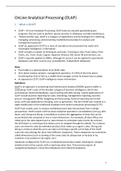Resume
Summary Data Management: OLAP
- Cours
- Data Management
- Établissement
- Katholieke Universiteit Leuven (KU Leuven)
Business Information Management - Data Management. Module 3: OLAP. This document contains all the slides, notes from 2 students and extra information collected on Internet. I had a 15 out 20 for this subject.
[Montrer plus]



